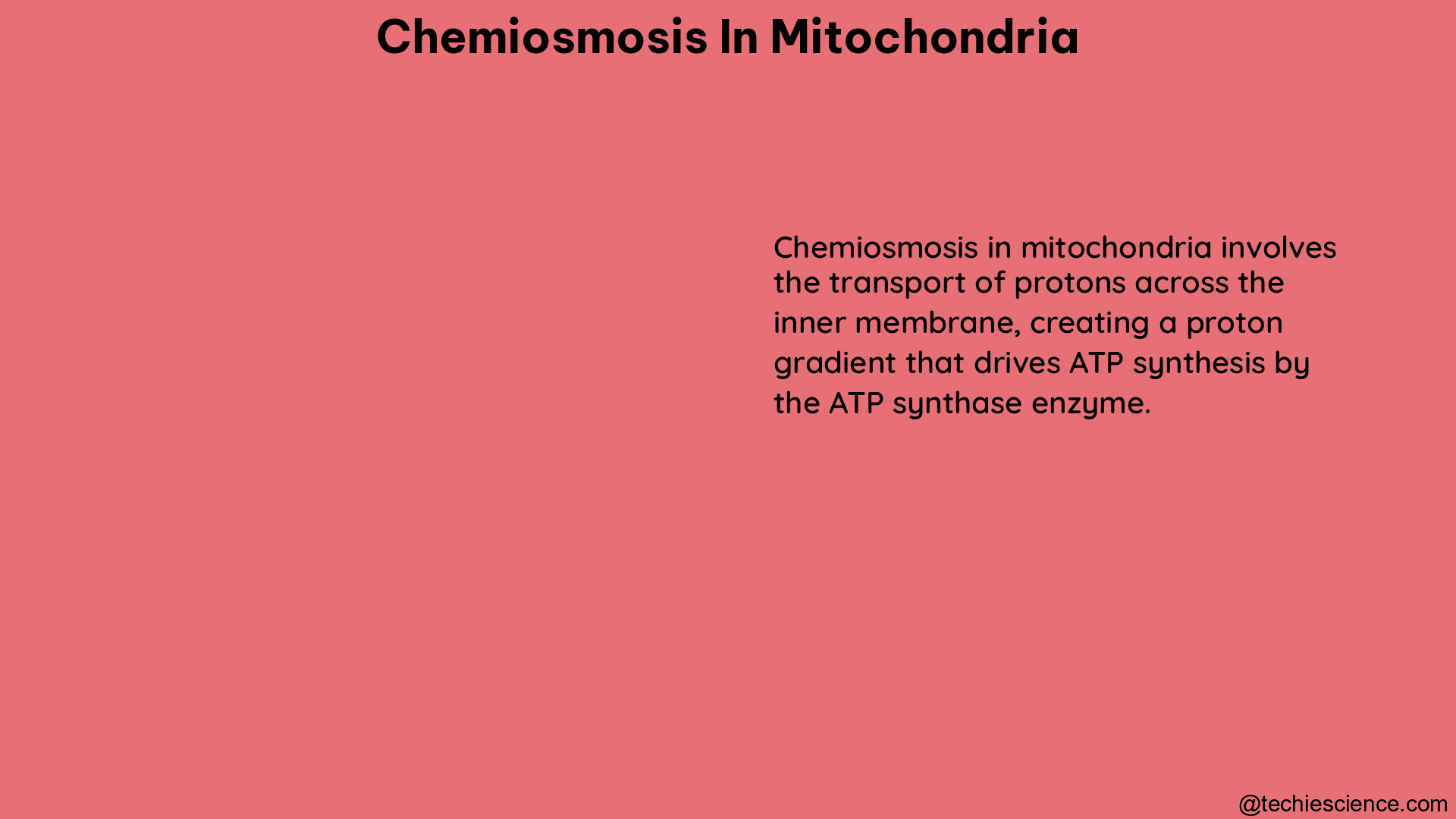Chemiosmosis in mitochondria is a fundamental process that generates ATP, the primary energy currency of the cell. The chemiosmotic theory, proposed by Peter Mitchell in 1961, explains how this process works. According to the theory, the electron transport chain (ETC) pumps protons across the inner mitochondrial membrane, creating a proton gradient or proton-motive force. The energy stored in this gradient drives the synthesis of ATP by ATP synthase, a membrane-spanning protein complex.
Understanding the Proton-Motive Force
The proton-motive force generated by the ETC has two components: a chemical gradient (due to the difference in proton concentration across the membrane) and an electrical gradient (due to the separation of charges). The magnitude of this force can be quantified by measuring the electric potential (in millivolts) and the pH difference across the membrane. The total proton-motive force (Δp) can be calculated using the Nernst equation:
Δp = Δψ – (2.303 * RT / F * ΔpH)
Where:
– Δψ is the electric potential
– R is the gas constant
– T is the absolute temperature
– F is the Faraday constant
– ΔpH is the pH difference
The proton-motive force can range from 150 to 220 millivolts, depending on the organism and the physiological conditions.
Efficiency of Chemiosmosis

The efficiency of chemiosmosis in mitochondria can be estimated by comparing the free energy change of proton translocation (ΔG) with the free energy change of ATP synthesis (ΔG’). The ΔG of proton translocation can be calculated using the formula:
ΔG = -nFΔp
Where:
– n is the number of protons translocated per ATP synthesized
The ΔG’ of ATP synthesis can be calculated using the formula:
ΔG’ = -ΔG°’ + RT ln [ADP][P i] / [ATP]
Where:
– ΔG°’ is the standard free energy change
– [ADP], [P i], and [ATP] are the concentrations of ADP, inorganic phosphate, and ATP, respectively
The efficiency (η) of chemiosmosis can be calculated as:
η = -ΔG / ΔG’
Typically, the efficiency of chemiosmosis in mitochondria is around 60-70%, meaning that 60-70% of the energy released by the ETC is used to synthesize ATP.
Experimental Evidence
Experimental data support the chemiosmotic theory. For example, the acid-bath experiment of Uribe and Jagendorf (1984) demonstrated that ATP could be synthesized in the dark and without electron transport by loading the inner space of the grana disk membranes of spinach chloroplasts with protons. This experiment provided direct evidence for the proton gradient as the driving force for ATP synthesis.
Moreover, the structures of all the proteins involved in the chemiosmotic mechanism have now been determined, including that of the ATP synthase, the molecular machine which uses the electrochemical gradient to phosphorylate ADP to ATP, and the components of the electron transport chain.
Factors Affecting Chemiosmosis
Several factors can influence the efficiency and rate of chemiosmosis in mitochondria:
-
Membrane Potential: The electric potential difference across the inner mitochondrial membrane is a crucial factor. A higher membrane potential (more negative inside) can drive more efficient ATP synthesis.
-
pH Gradient: The pH difference across the membrane, with a lower pH (more acidic) in the intermembrane space, is also essential for maintaining the proton-motive force.
-
Substrate Availability: The availability of substrates like ADP, inorganic phosphate, and oxygen can affect the rate of ATP synthesis, as they are required for the overall process.
-
Uncoupling Agents: Certain molecules, such as 2,4-dinitrophenol (DNP), can uncouple the proton gradient from ATP synthesis, dissipating the proton-motive force and reducing the efficiency of chemiosmosis.
-
Mitochondrial Dynamics: The shape, size, and distribution of mitochondria within the cell can also influence the efficiency of chemiosmosis, as they affect the surface area available for the ETC and ATP synthase.
Significance of Chemiosmosis
Chemiosmosis in mitochondria is a fundamental process that powers the majority of cellular ATP production. It is a highly efficient mechanism that couples the energy released by the ETC to the synthesis of ATP, the primary energy currency of the cell. Understanding the intricacies of chemiosmosis is crucial for comprehending cellular bioenergetics, as it underpins the ability of cells to generate and utilize energy for various cellular processes.
Conclusion
Chemiosmosis in mitochondria is a well-established process that can be quantified by measuring the proton-motive force and calculating the free energy changes involved in proton translocation and ATP synthesis. The chemiosmotic theory, which explains this process, has been validated by numerous experimental studies and has become a fundamental concept in bioenergetics. By understanding the factors that influence chemiosmosis and the mechanisms involved, researchers can gain insights into the regulation and optimization of cellular energy production, with potential applications in fields such as biotechnology, medicine, and energy research.
References:
– Alberts, B., Johnson, A., Lewis, J., Raff, M., Roberts, K., and Walter, P. (2002). Electron-transport chains and their proton pumps. In Molecular biology of the cell (4th ed.). New York, NY: Garland Science. Retrieved from http://www.ncbi.nlm.nih.gov/books/NBK26904/.
– ATP-ADP translocase. (2015, January 28). Retrieved September 16, 2015 from Wikipedia: https://en.wikipedia.org/wiki/ATP%E2%80%93ADP_translocase.
– Berg, J. M., Tymoczko, J. L., and Stryer, L. (2002). Many shuttles allow movement across the mitochondrial membranes. In Biochemistry (5th ed., section 18.5). New York, NY: W. H. Freeman. Retrieved from http://www.ncbi.nlm.nih.gov/books/NBK22470/.
– Brown adipose tissue. (2015, August 25). Retrieved September 16, 2015 from Wikipedia: https://en.wikipedia.org/wiki/Brown_adipose_tissue.
– Caprette, D. R. (2005, 31 May). The electron transport system of mitochondria. In Experimental biosciences. Retrieved from http://www.ruf.rice.edu/~bioslabs/studies/mitochondria/mitets.html.
Hey! I am Sneha Sah, I have completed post graduation in Biotechnology. Science has always been fascinating to me and writing is my passion. As an academic writer my aim is to make Science easy and simple to learn and read.